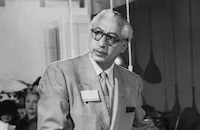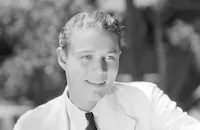Masterson of Kansas

Brief Synopsis
Cast & Crew
William Castle
George Montgomery
Nancy Gates
James Griffith
Jean Willes
Benny Rubin
Film Details
Technical Specs

Synopsis
In the volatile frontier town of Dodge City, Kansas during the late 1870s, Sheriff William Barclay "Bat" Masterson's confrontation with renowned gambler and killer John Henry "Doc" Holliday is halted by federal marshal Wyatt Earp, friend of both. Doc agrees to leave Bat alone for the time being, provided he can gamble in town. Wyatt asks Bat to go into Indian territory to retrieve Amos Merrick, negotiator of a recent peace treaty between several Indian nations and the white pioneers, and who is accused of the murder of Army officer, Col. Daily. Bat agrees and seeks out Chief Yellow Hawk, with whom, he learns, Amos is staying. Yellow Hawk resists, allowing Amos to return to Dodge City with Bat, but when Amos insists on going, the chief warns Bat that if harm comes to Amos, his people will attack. Amos' daughter, schoolteacher Amy, journeys from the East to be with her father during his trial and is outraged when several cattlemen, led by Charlie Fry, testify against Amos, whom they resent for partitioning their grazing land to the Indians in the peace agreement. When cattleman Clay Bennett testifies that he witnessed Amos shoot Daily, Amos is convicted and sentenced to be hanged. Wyatt, concerned about the rising tension in town, arranges to have Amos transported to Hays City for his execution, and Amos pleads with Bat to speak with Yellow Hawk. Later, the chief, already aware of Amos' sentence, tells Bat that several tribesmen witnessed Bennett's presence at the river at the time of Daily's murder, but knew no white court would accept Indian testimony. Having learned that Bennett fled Dodge City immediately after testifying, Bat nevertheless promises Yellow Hawk to find him in exchange for the chief's assurance of withholding an attack. Yellow Hawk guarantees peace as long as Amos remains alive. Bat returns to town as the Army escort arrives to transport Amos with Wyatt and his brother Virgil. Before departing, Wyatt tells Bat that, as Bennett owes Doc $3,000 in gambling debts, Doc must know his whereabouts. When Bat confronts Doc in the saloon, however, Doc says that Bennett deeded him his interest in a large cattle herd as security for his debt, so he does not need to know Bennett's location. Later, Amy asks Doc about Bennett and he reveals his suspicion that Bennett has gone to see his wife, singer Dallas Corey, performing in the Red Front saloon in the nearby town of Quolari. Doc is then approached by Fry and his men, who offer to hire him to kill Bat, but Doc refuses, claiming he never kills during a lucky gambling streak. Fry and his gang plan to organize a vigilante group to go after Amos, knowing his death will break the peace treaty and restore their land. Amy then tells Bat about Dallas, but he refuses to take her with him to Quolari. Later, along the trail, however, Bat is overtaken by Amy and Doc, whom she has convinced to escort her. Bat's protests are interrupted by Indian drums and smoke signals which reveal a large band heading toward the pass between Quolari and Hays City. Bat realizes the band intends to ambush Amos' coach and asks Doc to help him cut them off. Fry's vigilante gang lies in wait for the coach and succeed in wounding several soldiers and Virgil before Bat and Doc break up the attack. Doc rides on in the coach with Wyatt and Amos, while Bat takes Amy to Quolari to search for Bennett. Fry and the surviving vigilantes arrive in Quolari first and force a nervous Bennett to agree to kill Bat. When Bat arrives to question Dallas, he discovers and disarms Bennett, then arranges with the couple to fake Bennett's murder. Amos' coach stops in Quolari and Doc remains behind while Amy, believing that Bennett is indeed dead, grows distraught, convinced that her father is doomed. Meanwhile, Bat hides Bennett in the loft of the livery stable. Fry, who also believes Bennett is dead, bribes swindler and card dealer Joe Tyler to engage Doc in cards and break his win streak, angering him into killing Bat. Fry then discovers Bennett's murder was faked, and Amy overhears his plan to attack Bat in the livery. Bat turns to Doc to help him against Fry and his remaining men and Doc reluctantly agrees. Fry nevertheless escapes after the shootout and rides to Hays City hoping to instigate a lynch mob to kill Amos. Bat and Doc arrive in time to join Wyatt in breaking up the lynch mob and kill Fry. After Bennett's testimony frees Amos, Doc decides to move on and Bat eventually returns East with Amy.

Director

William Castle
Cast

George Montgomery

Nancy Gates

James Griffith

Jean Willes

Benny Rubin

William A. Henry
David Bruce
Bruce Cowling

Gregg Barton
Donald Murphy
Gregg Martell
Sandy Sanders
Jay Silverheels
John Maxwell
Wesley Hudman
Leonard Geer
Crew
Mischa Bakaleinikoff
Henry Batista
Leon Chooluck
Sidney Clifford
Francis Cugat
Jack Erickson
Henry Freulich
Charles S. Gould
Douglas Heyes
Sam Katzman
John Livadary
Paul Palmentola

Videos
Movie Clip




Hosted Intro
Film Details
Technical Specs

Articles
Masterson of Kansas
In real life, Masterson (born in Illinois in 1855), was initially a deputy marshal under Earp in Dodge City. In 1877 he campaigned for and won the post of county sheriff, where he enforced a curfew and gun restrictions on the often lawless town. In 1879, he was appointed U.S. deputy marshal but lost his bid for re-election primarily because of accusations by a newspaper editor that he was crooked. After that, he made a living as a gambler in such Western boom towns as Leadville, Deadwood, and Tombstone (where he came to know Holliday, a friend of Earp's). Eventually he went East to New York, where he was for a time U.S. deputy marshal (appointed by his friend President Teddy Roosevelt) and editor for the New York Morning Telegraph. His three-times-a-week column was one of the paper's most popular. He lost his law enforcement job when Roosevelt left office but stayed on in New York, continuing his newspaper work. On October 25, 1921, in the middle of writing his column, he died at his desk of a sudden heart attack.
The Western legend has been portrayed on screen a number of times by, among others, Joel McCrea and Randolph Scott. Gene Barry played Masterson in a long-running TV series. Here the role is taken on by George Montgomery, a former boxer who, while never a top-rank star, made a string of popular action-packed Westerns in the 1950s. During this time, he was married to singer Dinah Shore, a successful recording and television star. In later life, he turned his self-taught talents to sculpture and created busts of such Western film legends as John Wayne, Gene Autry, Randolph Scott and Clint Eastwood.
Masterson of Kansas was directed by William Castle, better known for his horror movies and the over-the-top gimmicks and marketing devices he used to draw audiences. Among the pictures he directed were such early 60s schlock-horror classics as The Tingler (1959), which used a vibrating device attached to theater seats for shock effect; Thirteen Ghosts (1960), released in "Illusion-O," requiring viewers to use special glasses to see the ghosts; and the late Joan Crawford vehicles Strait-Jacket (1964) and I Saw What You Did (1965). As a producer, he gained a measure of respectability when he produced Rosemary's Baby (1968) for director Roman Polanski and even appeared in a cameo. He also served as associate producer and uncredited second unit director on Orson Welles' film noir The Lady from Shanghai (1947). John Goodman played a character based on Castle in the affectionate spoof of the B-movie industry Matinee (1993).
The chief of the Kiowa in this picture is played by Jay Silverheels, famous as the faithful Indian companion Tonto in the long-running Lone Ranger TV series and subsequent spin-off films. The Canadian-born son of a Mohawk chief, Silverheels entered the movie business in 1937 and worked steadily through 1974, although always typecast as the stereotypical Indian character. In later years, he became a spokesperson for improving the portrayals of Indians. He died in 1980.
Director: William Castle
Producer: Sam Katzman
Screenplay: Douglas Heyes
Cinematography: Henry Freulich
Editing: Henry Batista
Art Direction: Paul Palmentola
Original Music: Mischa Bakaleinikoff (uncredited)
Cast: George Montgomery (Bat Masterson), Nancy Gates (Amy Merrick), James Griffith (Doc Holliday), Bruce Cowling (Wyatt Earp), Jay Silverheels (Yellow Hawk).
C-73m.
by Rob Nixon

Masterson of Kansas
Quotes
Trivia
Notes
The working title of this film was Bat Masterson, Bad Man. William Barclay "Bat" Masterson was, as the film indicates, sheriff of Dodge City from 1877 to 1880 and was, according to some sources, a member of the Dodge City Gang that ran the town. Like the movie, Masterson was rumored to have been friendly with Wyatt Earp and Doc Holliday. Unlike the film, the real John Henry "Doc" Holliday was a dentist, not a general practitioner. For more information about Masterson, please consult entry below for the 1943 United Artists release The Woman of the Town. For information about Holliday, consult the entry for the 1941 Universal film Badlands of Dakota (above).















